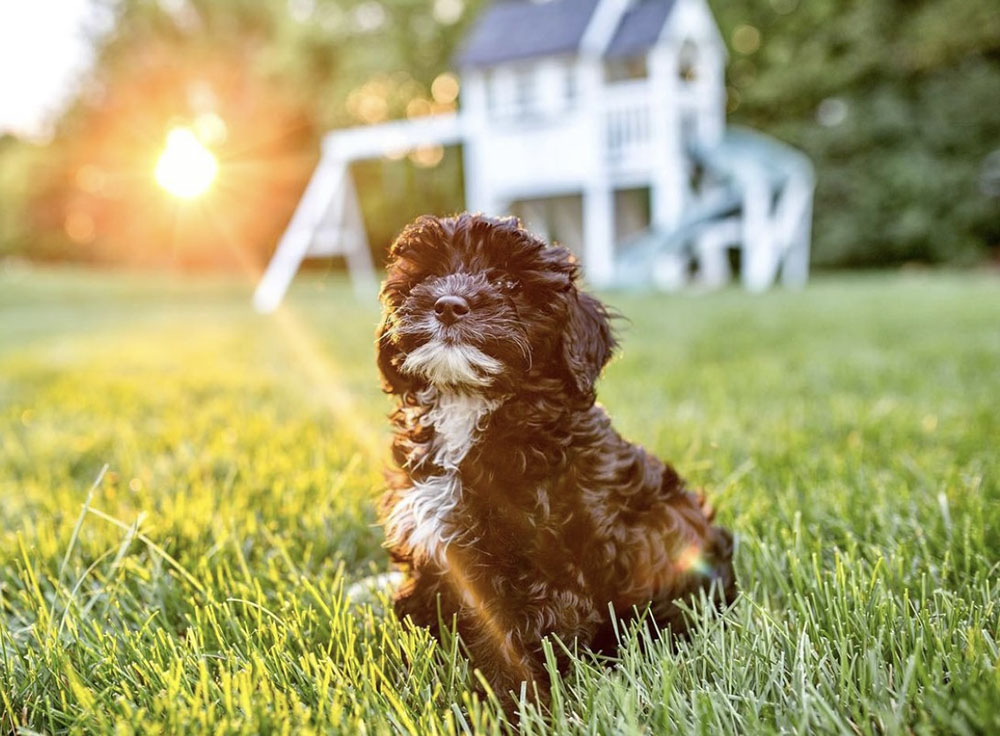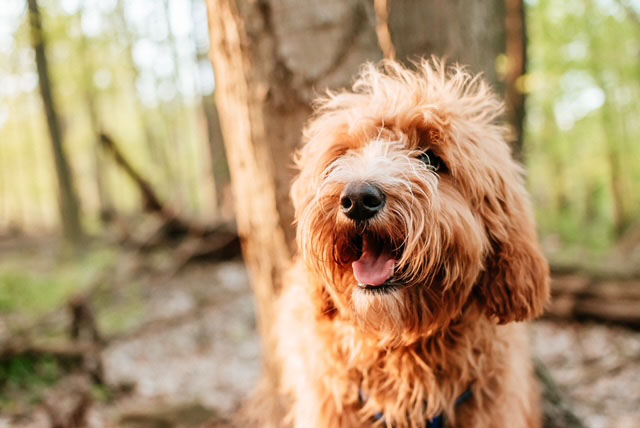Table of Contents
- Understanding Your Options: How Different Systems Work
- Why Invisible Dog Fences Fail: Scientific Research Reveals the Truth
- Hidden Dangers of Invisible Dog Fences: 6 Critical Safety Issues
- Even If They “Work,” At What Cost?
- Exploring Safer Alternatives
- Our Experience as Holistic Breeders
- Frequently Asked Questions
I completely understand the appeal: You want to give your dog freedom to enjoy your beautiful yard without the expense and visual impact of traditional fencing. Invisible fencing seems like the perfect solution – it’s often more affordable, doesn’t block your view, and the companies make it sound so simple and effective.
As holistic breeders who’ve been in this wonderful world for years, I’ve had this exact conversation with many loving families. Every single one of them was trying to make the best decision for their dog, and I have so much respect for that thoughtful approach.
But over the years, I’ve learned some things about these systems that I wish I’d known earlier – information that might help you make the most informed and confident decision for your family. Let me share what I’ve discovered, not to judge anyone’s choices, but because I care deeply about dogs and the families who love them finding the best path forward together.
Understanding Your Options: How Different Systems Work
When we talk about “invisible fencing,” we’re really discussing two main types of shock-based containment systems, and I think it helps to understand how each works:
Traditional Underground Wire Systems use a buried wire around your property that communicates with a special collar. When your dog approaches the boundary, the collar delivers a warning beep, followed by an electric shock if they continue forward.
GPS-Based Wireless Systems are newer technology that uses satellite positioning to create a virtual boundary through an app. When your dog’s GPS collar detects they’ve crossed the invisible line, it delivers the same type of electric shock.
Both approaches use the same fundamental principle: teaching your dog to avoid certain areas by associating them with an unpleasant or painful experience. The technology differs, but the training method is essentially the same.

Why Invisible Dog Fences Fail: Scientific Research Reveals the Truth
Research shows us what the scientific community has discovered about these systems, and I think it’s important information for making the best decisions for your dog.
The American Veterinary Society of Animal Behavior, which represents veterinarians and doctorate-level animal behaviorists, has studied these systems extensively. Based on their research review of multiple scientific studies, they’ve found that shock-based training methods can cause both immediate stress responses and longer-term behavioral changes that weren’t intended.
European veterinary researchers have documented similar findings, noting that dogs often learn to associate their owners and environment with the anticipation of discomfort, which can affect their overall well-being and the bond with their families.
I share this research not to create guilt, but because I believe you deserve to have complete information when making decisions about your dog’s care – and because there are so many wonderful alternatives available.
Hidden Dangers of Invisible Dog Fences: 6 Critical Safety Issues
Let me share some key safety concerns that have emerged from research and real-world experience. While I hope this information helps guide your decision-making, I also want you to know that there are effective, stress-free alternatives that can give your dog freedom while keeping them truly safe.
1. When the Power Goes Out or GPS Fails, Your Protection Disappears
Picture this: a storm rolls through your neighborhood (exactly when your dog is most likely to be scared and want to run), and boom – your power goes out. If you have a buried wire system, guess what else stops working? Your containment system.
GPS-based systems have their own vulnerabilities. Satellite signals can be disrupted by weather, tall buildings, or heavy tree cover. When the GPS can’t accurately track your dog’s location, the system either fails to work at all or gives false corrections.
Unlike a real fence that’s still there protecting your yard no matter what, shock-based containment systems fail when you need them most. And let’s be honest, when was the last time you remembered to change the batteries in your smoke detector right when you were supposed to? The same thing happens with those collar batteries – they die, often without you realizing it, leaving your dog completely unprotected.
I’ve heard too many stories of dogs escaping during storms because their shock-based containment system simply stopped working when they needed it most.
2. It Only Works One Way – And That’s the Problem
Here’s the thing that really gets me: shock-based containment systems might keep your dog IN, but they do absolutely nothing to keep danger OUT.
Let me share a story that still breaks my heart. A close friend of mine had a little Yorkshire Terrier who was perfectly trained to respect her buried wire boundary. That little dog never once tried to leave the yard – she was a model student. One evening, she went outside for a quick potty break, just like she had hundreds of times before. A coyote came into the unfenced yard and took her. The shock-based system that had worked so well to contain that sweet Yorkie couldn’t do a thing to protect her when danger came looking.
Think about what else can just walk into your “protected” yard:
- Aggressive dogs from the neighborhood
- Wildlife like coyotes, foxes, or even larger predators depending on where you live
- People with bad intentions
- Stray animals that might be sick or carrying diseases
Your dog is essentially trained to stay put while anything dangerous can enter their space.
3. The Hidden Physiological Impact: Chronic Stress and Elevated Cortisol
Here’s something that many families don’t realize: even when dogs seem to “accept” shock-based systems without obvious behavioral changes, their bodies may be experiencing ongoing stress that we can’t see.
Research has consistently shown that dogs trained with shock collars have significantly elevated cortisol levels – the body’s primary stress hormone. When cortisol remains chronically elevated, it can suppress the immune system, affect digestion, disrupt sleep patterns, and even impact brain development in young dogs.
What makes this particularly concerning is that dogs who appear outwardly calm may still be experiencing this internal stress response. Studies have found that dogs continue to show elevated stress markers even when they’re not being shocked – their bodies have learned to anticipate potential pain simply from being in the environment where shocks occurred.
This creates a cycle where dogs live in a constant state of low-level anxiety, even during times that should be relaxing and enjoyable. The long-term health implications of chronic cortisol elevation can affect everything from their immune system to their ability to learn new, positive behaviors.
4. The Emotional Impact We Often Don’t See
Dogs are incredibly sensitive creatures, and living with the constant possibility of receiving a shock creates a level of stress that we might not immediately recognize, but that can profoundly affect their well-being.
Research published in veterinary behavior journals shows that dogs contained behind electric systems tend to become more reactive and aggressive toward strangers and even family members because of anxiety and frustration. Studies have found that dogs without previous aggression problems actually become more likely to develop behavioral issues when shock-based systems are used.
The American Veterinary Society of Animal Behavior explains that aversive training methods have a damaging effect on both animal welfare and the human-animal bond, causing increased anxiety and fear-related behaviors.
What breaks my heart is that these changes can be subtle at first – maybe your normally friendly dog becomes a bit more hesitant with strangers, or seems more on edge during regular activities. These shifts in personality often happen gradually, so we might not connect them to the containment system.
5. The Coming-Home Problem Nobody Mentions
Here’s a scenario that’ll make your head spin: let’s say your system fails and your dog escapes (which happens with both buried wire and GPS systems more often than you’d think). You find him and start heading home. But what happens next depends on your system type, and neither scenario is good.
With buried wire systems, if the power came back on while you were gone, you’ve got a problem. The closer you get to your house with your dog, the stronger that shock signal gets. Your poor dog is getting zapped for trying to come HOME.
GPS systems can be even trickier – the virtual boundary is always “on,” so your dog gets shocked for crossing back into the safe zone. Talk about sending mixed messages! How are you supposed to get him back in the yard safely when the system is literally punishing him for returning?
The shock field works in both directions with these systems, creating a barrier that punishes dogs for leaving AND for coming back. It’s like a cruel catch-22 that can leave your dog stranded away from safety.
6. When Smart Dogs Figure Out Both Systems Pretty Quick
Dogs are incredibly intelligent, and many of them become escape artists when it comes to shock-based containment:
With buried wire systems: Some dogs learn to time the electrical pulses and make a run for it during the gaps. Others just grit their teeth, take the shock, and walk right through to freedom.
With GPS systems: Dogs quickly learn that certain areas (like under dense trees or near tall buildings) seem to have “dead zones” where they don’t get corrected. Some figure out that if they move slowly, the GPS doesn’t register the movement as quickly.
Once a dog figures out they can outsmart either system, your expensive containment setup becomes a very costly yard decoration.

A Deeper Question: Even If They “Work,” At What Cost?
Let me share something that’s been on my heart: even in cases where invisible fencing systems function perfectly without technical failures, we need to ask ourselves – at what cost to our dogs?
Sometimes aversive training methods do achieve the immediate behavior we’re looking for. A dog may learn to stay within boundaries when trained with shock. But while we might have “solved” the containment issue, we often create other problems – increased anxiety, fearfulness, or even aggression that didn’t exist before.
This brings us to a fundamental question about our relationship with our dogs: as their guardians and advocates, are we comfortable using pain and fear as training tools when proven alternatives exist that work just as effectively?
Just like with human children, our dogs depend on us to love them, protect them, and make decisions in their best interest. They trust us completely. When we have the choice between methods that build confidence and joy versus those that rely on discomfort and anxiety, what does that choice say about the kind of relationship we want with our dogs?
This isn’t just about training effectiveness – it’s about who we want to be as pet parents and what kind of life we want our dogs to experience.
Exploring Safer Alternatives
I hope sharing these considerations doesn’t feel discouraging – that’s truly not my intention. Instead, I’d love to help you think through some alternatives that might give you the peace of mind you’re seeking.
Physical Fencing: More Options Than You Might Think
I know traditional fencing seems expensive and maybe not aesthetically pleasing, but today’s options are really impressive. There are beautiful designs that can actually enhance your property value while providing reliable, 24/7 protection.
Consider that a good fence is typically a one-time investment that lasts decades, whereas electronic systems need ongoing maintenance, battery replacements, and eventual replacement of the entire system.
Supervised Freedom
Some families find that spending outdoor time with their dogs creates wonderful bonding opportunities while ensuring safety. Yes, it requires more hands-on involvement, but many families tell me this has actually strengthened their relationship with their pets.
Professional Training for Recall and Boundaries
Working with a qualified, positive-reinforcement trainer can teach reliable recall and boundary respect without any electronic devices. This approach takes more time and patience, but it builds a stronger relationship and creates genuine understanding rather than fear-based compliance.
The American Veterinary Society of Animal Behavior emphasizes that reward-based training is not only more humane but often more effective in the long run.
Our Experience as Holistic Breeders
As holistic breeders, our approach has always been to consider the whole dog – their physical health, emotional well-being, and the kind of life experiences that help them thrive. So it probably won’t surprise you that we don’t support training methods that rely on pain or fear.
I want to be transparent about something: over our years of breeding, we’ve unfortunately had several families contact us months or years after adopting their puppies, asking for help with behavioral changes they believe are related to their shock-based containment systems.
These are loving, caring families who thought they were making the best choice. They reached out because they wanted to help their pets feel happy and confident again, and they were seeking guidance on how to support their dogs’ well-being.
These conversations, while touching on difficult topics, always inspire me because I can hear the deep love and commitment in their voices. They remind me why it’s so important to share what we’ve learned – so other families can make informed choices from the start.
This is why we’ve made the decision to work only with families who choose physical containment methods. It’s not about judgment; it’s about what we’ve learned from experience.

Our Commitment to You
If you’re considering one of our puppies, please know that we’re here to support you in creating the safest, most loving environment possible. We’re happy to discuss containment options, share experiences from other families, and help you think through what might work best for your specific situation.
For more helpful resources, check out our FAQ section and useful links page for additional guidance on puppy preparation and care.
Our goal isn’t to make decisions for you, but to ensure you have the information and support you need to make choices you’ll feel good about for years to come.
Thank you for taking the time to research this important decision. Your thoughtfulness in considering your dog’s safety and well-being shows the kind of loving home every puppy deserves.
Related Articles
Looking for more guidance on responsible puppy ownership? These articles might help:
- 3 Challenges Puppy Parents Face – Prepare for common hurdles in puppy raising
- Finding the Best Breeder – What to look for in a responsible breeder
- Temperament Testing in Puppies – Understanding your puppy’s personality
Frequently Asked Questions
Are invisible dog fences safe?
No, invisible dog fences are not safe. Research shows they pose serious risks including:
- System failures during power outages when dogs need protection most
- No protection from external threats (coyotes, aggressive dogs, intruders)
- Elevated cortisol levels causing chronic stress and health problems
- Increased anxiety and behavioral issues, even in previously well-behaved dogs
- Re-entry problems that punish dogs for returning home
Physical fencing remains the safest option for pet containment.
Which countries have banned shock collars?
Many countries have banned shock collars for dog training, including:
- England (as of February 2024)
- Denmark
- Norway
- Sweden
- Austria
- Germany
- Netherlands
- Spain
- Parts of Australia and Quebec, Canada
These bans followed extensive research showing shock-based training causes stress and behavioral problems in dogs.
Are invisible dog fences ethical?
This is a thoughtful question that many caring pet owners ask. From an ethical standpoint, the concern centers around whether it’s appropriate to use pain or fear to control our dogs’ behavior when other effective methods exist. The American Veterinary Society of Animal Behavior emphasizes that training should focus on teaching dogs what TO do rather than punishing them for unwanted behaviors. Many animal welfare experts believe that since we have proven alternatives that work just as well without causing stress or discomfort, the ethical choice is to choose those methods instead.
Are goldendoodles particularly sensitive to shock-based training?
Goldendoodles, with their intelligent and sensitive nature inherited from both poodles and golden retrievers, can be especially affected by fear-based training methods. Their eager-to-please personality means they often respond beautifully to positive reinforcement, making shock-based systems unnecessary. Many goldendoodle families find that their dogs thrive with gentle, consistent training that builds confidence rather than creating anxiety.
How do I find a qualified trainer for positive reinforcement methods?
Look for trainers certified through reputable organizations that emphasize science-based, positive methods. Your veterinarian can often provide referrals to qualified professionals in your area.
Why don’t you work with families who plan to use invisible fencing?
As holistic breeders, we’ve made the decision to work only with families who choose physical containment methods or other force-free alternatives. This isn’t about judgment – it’s about what we’ve learned from experience and our commitment to each puppy’s long-term well-being. We want to ensure every dog we place has the best possible start in life, free from methods that research shows can cause stress or behavioral issues.
About Maple Hill Doodles: As holistic breeders, we believe every puppy deserves a loving family that prioritizes their safety, well-being, and happiness. We’re committed to supporting our families with information, guidance, and ongoing support to help create the best possible life for each dog we place.



